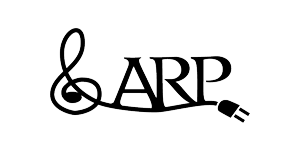
American company ARP Instruments (“née” Tonus) turned popular owing to its founder and chief engineer Alan Robert Pearlman who was once inspired by Walter (Wendy) Carlos and the album “Switched-On Bach” which actually conduced to the company creation. ARP was formed in 1969 and soon was considered a prominent synthesizer maker despite the fact of going broke in 1981.
The company began with ARP 2002 production – their first analog module instrument though ARP 2005 became more popular thanks to its double matrix capabilities. The instrument comprised 15 modules including: VCO, envelope generators, filters, modulators, sequencer. Modular system also allowed to expand its functions by adding new modules. In 1971 a bulky “2005” was replaced by a more compact semi modular synth with new patches – ARP 2600 also known as Blue Marvin. Later the series encompassed 2600C Gray Meanie (keyboard, 2-voice polyphony); 2600P v1.0, v2.0, v3.0, v4.0; 2601 v1.0, v2.0, v3.0 (new design). The series became popular among music college and universities students due to its comprehensible control. The instruments included 3 VCOs, ADSR, LFO. ARPs distinctive feature is their pin matrix (kind of a patch board matrix into which pins are inserted in order to connect its components together) - quite different from that one in Moog which used to be the main ARP’s rival. Robert Moog himself would admit ARP’s some technical superiority.
In 1970 ARP’s first monophonic synthesizer came out and it was called Soloist. It had a 37-note keyboard with aftertouch support. ARP tried to imitate Hammond making it the reason of Soloist creation. Soloist got rid of the patch cords and made it possible to choose one of 18 factory patches thanks to the new set of toggle switches. Soloist was upgraded in 1972 now being called Pro Soloist. It had an increased number of patches (30) and used ROM chips as well as replaced the switches with pushbuttons. On the left side of the instrument there were 4 sliders to control sound and experiment with sound palette. ARP Explorer would inherit Pro Soloist functions a bit later. Pro/DGX, a modernized Pro Soloist version, was released 5 years after. The instrument grew in power and stability offered settings LED buttons making the work with sound unforced.
The year of 1972 was marked of course with the ARP Odyssey emergence – the instrument which appeared to be widely copied even long after ARP company’s failure to stay afloat. The synth became the main competitor in the rivalry “Moog vs others” turning it into “ARP Odyssey vs Minimoog” and earning a strong position on the market. Odyssey included the basic functions of ARP 2600 being more compact at the same time. It is an analog synthesizer with 2 VCOs (sine, square), LFO, filter, ADSR. The Odyssey line included Odyssey Mk I (2-pole VCF); Odyssey Mk II (4-pole VCF), Odyssey Mk III (with new Proportional Pitch Control technology).
ARP Axxe was launched as a once proclaimed “budget-proof” version of Odyssey. Despite its smaller dimensions it could give out a pretty astounding sound range and actually was quite popular among musicians.
In 1975 Omni series went into production. Then all the polyphonic synthesizers with an oscillator and filter per voice were too heavy and expensive and it was ARP which rethought this issue completely. The instrument had 3 sections: Strings, Bass and Synthesizer with the integration ability. The section operated with Mostek MK50240 generator and had a 49-voice polyphony. Omni 2 was released in 1977 now having a bass section and an updated chorus and clearly outperformed the predecessor.
ARP Quadra comprised 4 sections: simple but functional bass, great strings, polysynth (worse than in Chroma but still good), lead synth with 2 VCOs, excellent filter and mixer (/phase modulator). Sections allowed to use them separately or combined making miscellaneous sounds. This model offered 16 memory slots and a basic arpeggiator. Specialists point out that a true professional could go without a stack of instruments having just this one.
Being portable enough Solus of 1980, an analog monophonic synth, managed to press Odyssey and Axxe a little getting in line with them. The interface, mod wheel, 2 VCOs and affordable price made some people inclined to choose Solus.
ARP Chroma which was actually released by Rhodes in 1982 became a prominent though hard destined synthesizer. That was one of the first multifunctional microprocessor controlled synths offering 8 or 16 voices of polyphony (16 VCOs – 2 or 1 per voice respectively), 2-8-part multitimbrality, 16 LFOs, full set of filters and envelopes as well as a lofty price of $5300 (= brand new Pontiac Sunbird or General Motors 1500 Series pickup). The instrument allowed to save and store sounds on the tape and to integrate it with Apple computers accessing the external software sequencer but lacked MIDI due to being produced before MIDI mass implementation. It had a 64-note fully weighted keyboard supporting velocity and possible polyphonic aftertouch (with an external controller). There was also Chroma Expander produced – complete Chroma copy but without the keyboard.
ARP company became super famous and respectable among professionals. Even now its ideas are put into good (if not to say great) use by Korg, Arturia, Yamaha and others. ARP instruments were among the favorites of sound engineers. For example, ARP 2600 happened to be just what George Lucas needed for his Star Wars (R2-D2’s voice).
If you’re willing to make ARP an honorable part of your collection whether it’s small or big you’ve got 2 options: you can find it on the secondary market (hope you can find it though) or acquire Korg ARP Odyssey (thank you Korg) scrupulously recreated according to the original documentation and still working units completely regenerating the circuit design as it was while adding MIDI, USB, CV/Gate/Trigger. It’s also notable that Korg engineers supplied their version with all the 3 filter types (see mk1, mk2, mk3 versions of the original one).

